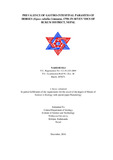Please use this identifier to cite or link to this item:
https://elibrary.tucl.edu.np/handle/123456789/1398| Title: | Prevalence of Gastro-Intestinal Parasites of Horses (Equus Caballus Linnaeus, 1758) in Seven Vdcs of Rukum District, Nepal |
| Authors: | Oli, Naresh |
| Keywords: | Horses;Gastro-Intestinal system;Parasites;Parasitic diseases |
| Issue Date: | 2016 |
| Publisher: | Central Department of Zoology Institute of Science and Technology Tribhuvan University Kirtipur, Kathmandu |
| Abstract: | Horse has been a loyal friend and trusted partner of human being. Horses are prone to infestation with both internal and external parasites. Present study was conducted in eastern seven VDCs of Rukum district to determine the prevalence of gastro-intestinal parasites in horses. The study was carried out from March 2016 to November 2016. A total of 105 faecal samples of horses (79 males and 26 females) were collected by using opportunistic random method during the month of April 2016. The collected faecal samples were preserved in 2.5% potassium dichromate and microscopically examined using concentration techniques. The overall prevalence of gastro-intestinal parasites was 84.76% (89/105). The total numbers of genera observed during faecal examination were 12 in numbers. Among them, the Strongylus sp. showed the highest prevalence (51.42%) followed by Eimeria sp. (20%), Trichostrongylus sp. (14.28%), Trichonema sp. (13.33%), Parascaris equorum (10.47%), Balantidium sp. (9.52%), Dictyocaulus sp. (8.57%), Triodontophorus sp. (7.61%), Gastrodiscus sp. (6.66%), Oxyuris equi (4.76%), Entamoeba sp. (3.80%), Shistosoma sp. (1.90%) and unidentified nematode larvae (7.61%). Three genera of parasites: Shistosoma sp., Triodontophorus sp. and Dictyocaulus sp. have been reported first time for Nepal in horses. Present study showed higher infection rate in females (92.30%) than in male horses (82.27%). No significant associations were observed between the prevalence of parasite rate with VDC-wise (χ2 = 5.7161; p>0.05) and prevalence rate with sex-wise (χ2 = 0.3346; p>0.05). But a significant association was observed between the infection status and study area (χ2 = 84.277; p<0.05) |
| URI: | http://elibrary.tucl.edu.np/handle/123456789/1398 |
| Appears in Collections: | Zoology |
Items in DSpace are protected by copyright, with all rights reserved, unless otherwise indicated.

